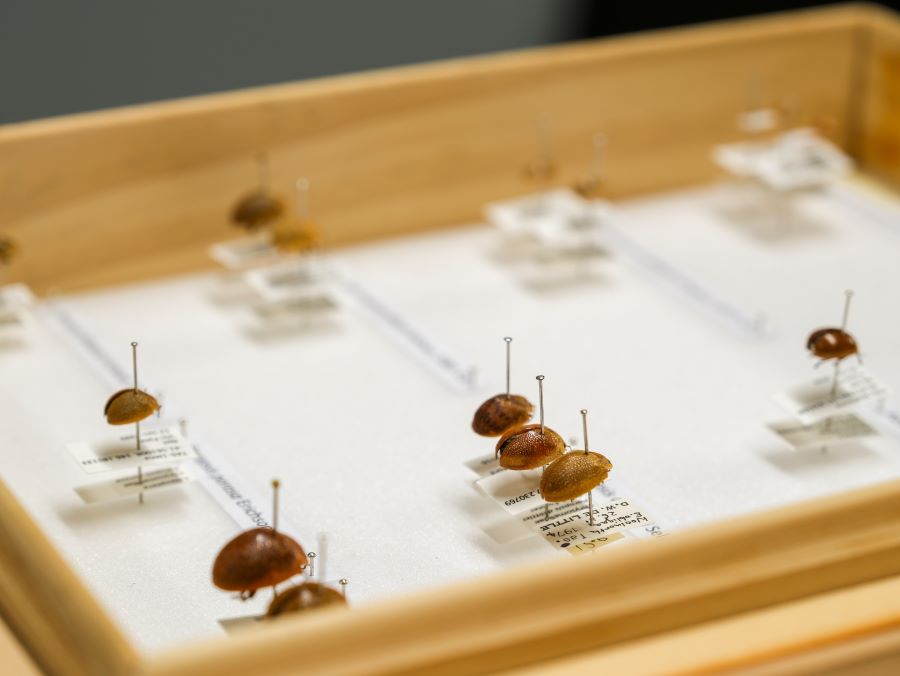Bugging out at new Tasmanian beetles
Established in 1948, the National Forestry Insect Collection (FRNZ) holds significance far beyond the modest confines of its home, a nondescript cabin on Scion’s Rotorua campus. The collection, largely made up of meticulously organised wooden boxes reminiscent of library volumes, is the most comprehensive compilation of forestry-related insects in New Zealand.
With around 175,000 specimens representing more than 3000 species, the National Forestry Insect Collection is a cherished national taonga that contains specimens from every rohe (region) across Aotearoa and many from beyond our borders. In October 2023, the collection welcomed its newest members, a series of Tasmanian eucalyptus leaf beetles.
Scion entomologist and FRNZ curator, Stephanie Sopow, says the collection is irreplaceable and fulfills three main functions: a diagnostic tool, archive, and a research tool.
“Not only does this resource provide our entomology team and collaborating researchers with diagnostic and archival resources, it’s also a vital component used to identify potential biosecurity threats to New Zealand’s native and planted forests.
“Each year, identifications are made on behalf of surveillance programmes managed by the Forest Owners Association (FOA), Ministry for Primary Industries (MPI), and Auckland Council, as well on behalf of concerned citizens.
“Through these endeavours, we fulfill diagnostic contracts valued at over $400,000, underlining our critical role in safeguarding forestry health.”
FRNZ is a working collection and growth over the last five years has averaged more than 1000 specimens per year, primarily from research projects involving the mass collection of insects to monitor biodiversity, or for biosecurity.

A gift from Tasmanian forests
Recently pinned into a set of new wooden display boxes is a comprehensive range of eucalyptus leaf beetles from the Chrysomelidae family found in Tasmanian forests. Largely under-represented in the collection until now, the 29 specimens representing 17 species were welcomed in October last year.
Their addition is mainly thanks to Dr Geoff Allen, a forestry entomologist from the University of Tasmania with more than 30 years’ experience. They were curated by his colleague, Dr Lynne Forster.
Dr Toni Withers, an entomologist who has been with Scion for a little over 25 years, says the beetles were generously donated to Scion’s entomology collection as a gesture of goodwill, marking the end of the MPIs’ Sustainable Food and Fibre Futures funded research project which relied heavily on the university.
“Over the years, Scion has enjoyed a meaningful collaboration with Dr Allen on research that has benefited New Zealand’s eucalyptus forestry industry by supplying researchers with beneficial insects that would eventually become biological control agents,” Withers says.
“For instance, in 2022 we released the parasitoid wasp (Eadya daenerys) in New Zealand as a biological control agent to control the larvae of the eucalyptus tortoise beetle (Paropsis charybdis) that has been damaging eucalypts in Aotearoa for over 100 years.”
Allen says the opportunity to work with Scion on mutually beneficial research has been a privilege.
“Their uptake and interest in the research and their collaborative teamwork has been one of the major highlights of my career.”
Scion entomologist Dr Carl Wardhaugh, whose expertise lies in the realm of beetles and who dedicates much of his time to studying the collection, says receiving these specimens significantly bolsters its representation of this important group.
“These beetles are relatively harmless in their native Australia, where natural enemies keep their populations in check. However, those that are invasive and have become established in New Zealand have few, if any, natural enemies and can cause considerable damage.
“Our borders are continuously vulnerable to invasions of beetles such as these and having an extensive reference collection of various species will greatly assist our diagnostic capability. In the case of a new biosecurity incursion, early detection combined with rapid identification of the organism offers the best chance of effective management.”
Our borders are continuously vulnerable to invasions of beetles such as these and having an extensive reference collection of various species will greatly assist our diagnostic capability - Carl Wardhaugh
Importance of nature’s time capsule
Biological collections hold the key to unlocking the past and future. They are unique in that their information is stored largely in the specimens themselves and cannot be easily replicated digitally.
Explaining the importance of this, Sopow says firstly, photos are not reliable for comparisons with fresh specimens as they can often lack resolution, colour accuracy, and detail.
“Additionally, the collection provides reference specimens of adult and immature stages of many species, which reduces the need for costly molecular identifications, where DNA or RNA sequences are extracted and analysed. Consequently, it saves both the resources and time typically involved in these processes.”
She says that as one of New Zealand’s oldest collections, it’s an important reservoir of historical information on forest insects, their distributions, host associations, and even their genes.
“Scientists often utilise insect collections when researching questions concerning evolution, biological invasion dynamics, environmental contamination, and temporal changes in insect demographics due to factors such as climate change or habitat fragmentation.
“It serves as nature’s time capsule, capturing moments in time, and we continue to contribute to its richness through various endeavours like biodiversity projects and biosecurity measures. History has shown us the importance of continually replenishing this repository with fresh specimens from both Aotearoa and beyond, ensuring the safeguarding of our future.”
